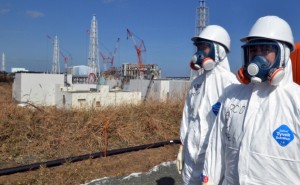Two years later and shock waves from Japan’s 2011 triple calamity are still being felt by the residents of Fukushima, the latest of which relate to predicitons of a huge leap in cancer in the area in coming years. However, the Japanese government is adamant that residents in the disaster area should take the results with a pinch of scepticism.
Struck by a 9.0 magnitude earthquake and a tsunami that slammed into Fukushima Daiichi nuclear power station, a nuclear disaster was only one of the catastrophes faced by Japan on March 11, 2011. Two years later, in the midst of ongoing reconstruction efforts, the World Health Organization (WHO) confirmed Japan’s greatest anxieties.
According to a report released last month by the WHO, people in the Fukushima Prefecture area have been definitively proven to be at a high-risk of exposure to cancer causing radiation associated with the Fukushima Daiichi nuclear power plant. The WHO claims that the contamination puts female infants at a 70% risk of developing thyroid cancer and a 6% risk of breast cancer in the course of their life. Male infants are estimated to have a 7% higher risk of developing leukemia. In addition, people who stayed in the Fukushima area for up to four months before evacuating are at a higher risk of developing other cancers than Japan’s general population.
Days after the report was released, Japan’s government released their own statement insisting that the warnings by the WHO cancer risks were overblown
However, the WHO has been accused of damming over exageration. Days after the report was released, Japan’s government released their own statement insisting that the warnings by the WHO cancer risks were overblown and that the report created unnecessary fears. Experts claimed the overall risk of developing cancer from the nuclear disaster is small and not absolute. Radiation exposure from the Fukushima accident is currently measured to have a small impact on the overall health of the nearby population, and much less outside the most affected areas. Many experts insist that the report is undeveloped, and the real risks will not be measurable for another 5-6 years.
Currently, two out of six nuclear plants are operational and the people are protesting for the government to shut down all nuclear plants. Protests for conservation, renewable energy system and quicker restoration to the people have been increasing in Japan. While, Japan’s Prime Minister, Shinzo Abe [translated] states, “We hope to work even closer with those affected by the disaster to rebuild the disaster areas and restore the livelihoods of those affected. I take this opportunity to strongly promise that we will also look to utilize the lessons learned across the nation to build a country that is stronger against disaster.”
With no plans to move into renewable energy just yet, Abe does plan to decontaminate the reactive land in addition to instill new safety standards in order to restart off-line nuclear reactors. Recently, laws have been passed for the relief and protection of Fukushima children and victims, allowing standard medical aid that will include long-term health monitoring and follow up care. Unfortunately, due to the lacking implementation of any legislation to execute relief, in addition to Abe’s need for the people’s July vote to stay Japan’s prime minister, skepticism ensues.
By CheRima Manayan




